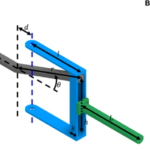Paper, Tunabot Flex: a tuna-inspired robot with body flexibility improves high-performance swimming
Tunas are flexible, high-performance open ocean swimmers that operate at high frequencies to achieve high swimming speeds. Most fish-like robotic systems operate at low frequencies (≤3 Hz) resulting in low swim speeds (≤1.5 body lengths per second), and the cost of transport (COT) is often one to four orders of magnitude higher than that of tunas. Furthermore, the impact of body flexibility on high-performance fish swimming remains unknown. Here we design and test a research platform based on yellowfin tuna (Thunnus albacares) to investigate the role of body flexibility and to close the performance gap between robotic and biological systems. This single-motor platform, termed Tunabot Flex, measures 25.5 cm in length. Flexibility is varied through joints in the tail to produce three tested configurations. We find that increasing body flexibility improves self-propelled swimming speeds on average by 0.5 body lengths per second while reducing the minimum COT by 53%. The most flexible configuration swims 4.60 body lengths per second with a tail beat frequency of 8.0 Hz and a COT measuring 18.4 J kg−1 m−1. We then compare these results in addition to the midline kinematics, stride length, and Strouhal number with yellowfin tuna data. The COT of Tunabot Flex’s most flexible configuration is less than a half-order of magnitude greater than that of yellowfin tuna across all tested speeds. Tunabot Flex provides a new baseline for the development of future bio-inspired underwater vehicles that aim to explore a fish-like, high-performance space and close the gap between engineered robotic systems and fish swimming ability.
Learn about our two Decals!
 Click here to find out more about our Fall Bioinspired Design Decal and our Spring Bioinspired Design in Action Decal – ALL MAJORS are welcome.
Click here to find out more about our Fall Bioinspired Design Decal and our Spring Bioinspired Design in Action Decal – ALL MAJORS are welcome.Berkeley BioDesign Community
 Click here to learn about the BioD: Bio-Inspired Design @ Berkeley student organization or here to signup for more info.
Click here to learn about the BioD: Bio-Inspired Design @ Berkeley student organization or here to signup for more info.Search
Student Login





I imagine that the neurological circuits underlying these processes are governed by both 2d spacing maps with their brains as…
to reduce the impact of car accidents, it may be possible to study the force diverting physics of cockroaches to…
you see this type of head-bobbing stability in many avian creatures related to pigeons like chickens. the head ability to…
not like they taught horses how to run! this is an example of convergent evolution where both sea creatures and…
The brain functions in a similar way with neuronal connections. our brains are able to utilize the multiplicity of connections…